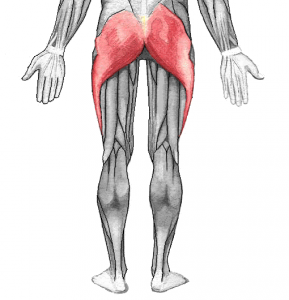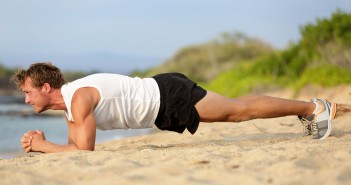The gluteus maximus is the largest of the gluteal muscles and one of the strongest muscles in the human body. Its action is to extend and to laterally rotate the hip, and also to extend the trunk.

Gluteal Muscles
The Role of the Glutes in the Golf Swing
Most amateur golfers (and many teaching professionals) mistakenly think that power in the golf swing is mostly generated with the shoulders and arms. This misunderstanding is the root cause of many swing faults.
The main source of power in a great golf swing is the ground.
In order to generate maximum power with minimum stress on the body, the ground is the first link in a kinetic chain that builds and transfers energy.
When you drive your legs into the ground, using predominantly the glutes, the ground pushes back (Newton’s third law). This is known as the ground reaction force (GRF).
GRF is transferred up your legs and into your pelvis, then further up the kinetic chain through your core, shoulders, arms, the golf club and ultimately the golf ball.
It is by generating and transferring GRF from the ground, up the kinetic chain, to the golf ball as efficiently as possible that we create maximum power in the golf swing.
The Backswing
During the backswing, the glutes (gluteus medius, gluteus maximus) in your right leg are loaded for stability, as the core muscles in the left side of your core are stretched and positioned to efficiently transfer and amplify power in the downswing.
The Transition and Downswing
During the transition, the lower body is moved into position for maximum stability and efficiency.
The left knee and hip are pulled directly over the left foot by the hips, the left gluteus maximus muscle contracts to create hip extension, and the muscles of the hip rotator cuff (including the gluteus medius and minimus) contract to create lateral stability within the hip and internal rotation of the hip joint.
This activation of the glutes enables you to drive into the ground, generating GRF, and helps to position your body so that the golf club is pulled down on the correct path.
Fixing Your Slice
Using your legs to position your body and generate power helps to prevent an over-the-top, slice-generating swing.
The lateral shift of the lower body, pulling the left knee and hip over the left foot, brings the plane of the club towards the target, and thus the arc of the club will automatically come more from the inside.
Pushing into the ground with your legs will also stabilise the hips and slow them down through impact, enabling the efficient transfer of energy up the kinetic chain, and again promoting an inside attack on the ball.
Saving Your Back
Without the stabilising effect of your legs pushing into the ground, you would rotate predominantly through the joints in your lower back, with minimal rotation actually occurring at the hip joint.
This lower back centred rotation is very inefficient and extremely stressful on your spine and supporting muscles, and the resulting wear and tear will eventually lead to discomfort, pain and possibly serious injury.
Gluteal Muscle Exercises
Mobility exercises:
Posterior Pelvic Tilt Exercise
If you have any questions or comments about this or other articles on Golf Loopy, please send us an email.
You May Also Like…
Overview of a Great Golf Swing, which summarises the correct movements in a great golf swing, and describes how the glutes help to power and stabilise the golf swing.
Golf Swing 102a. Setup: The Perfect Golf Stance Width
Golf Swing 102c. Setup: The Perfect Golf Weight Distribution and Balance
Golf Swing Drill 102. Setup: Perfect Golf Stance Width and Ball Position
An overview of the golf swing kinematic sequence, including a detailed analysis of the Downswing phase in Golf Swing Sequence and Timing.
Golf Swing Sequence and Timing – Common Faults, which gives a comparison of the kinematic sequence for typical amateurs and Tour Pros, showing the common flaws that may plague your own golf swing.
Golf Lag and the Compound Pendulum, which describes how you can use physics to generate more speed, accuracy and consistency in your golf swing, with less effort and less strain on your body.
Golf Anatomy and Kinesiology, a collection of articles describing the roles of the muscles involved in the golf swing.
Core muscles, which describes the muscles that run the length of your trunk and torso.
Ground reaction force (GRF), which describes how driving into the ground with your legs transfers power back up through your body.
Kinetic Chain, which describes how the different parts of your body act to transfer energy from the ground to the golf ball.




